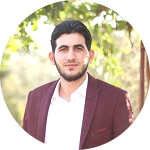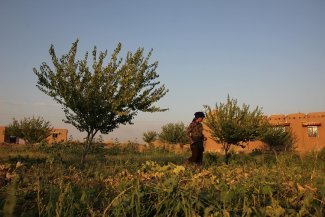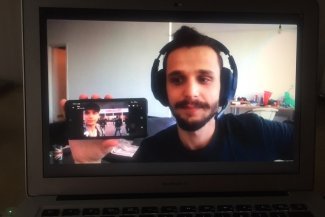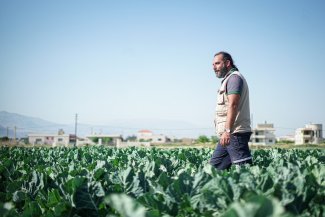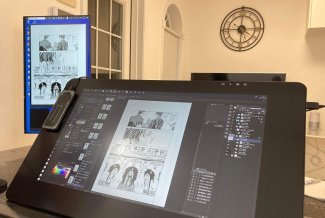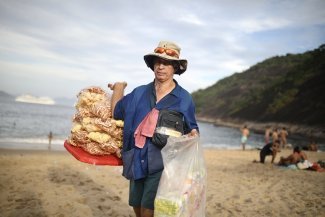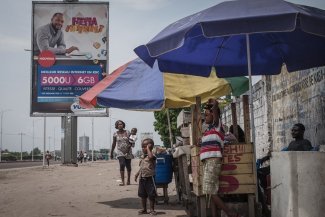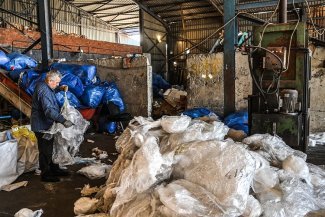Fifty-year-old Oum Mohammad picks cotton by hand from a field in the village of Killi, in the Idlib governorate, for a daily wage of 60 Turkish pounds (€1.85). It is the first time in over ten years that cotton has been grown in the region, which is now under the control of the Islamist group Hayat Tahrir al-Sham (HTS).
Opposite an olive grove, in the middle of fallow land, is a vast rectangular expanse of green, dotted with white flakes clinging to shrubs. A dozen or so farmworkers have been picking cotton by hand since seven in the morning, packing it into large jute sacks and then loading it onto a pick-up truck. It is the first time in over a decade that the countryside of Idlib, in north-west Syria, has been covered in white in late autumn.
Talal al-Abd, a farmer in the village of Killi, 20 kilometres from the city of Idlib, started growing cotton in the summer of 2023, following an initiative launched by the ‘Syrian Salvation Government’ led by the Islamist group Hayat Tahrir al-Sham (HTS), which took control of this ‘rebel’ territory in 2017. “The ‘government’ provided the farmers who wanted it with an advance in the form of several bags of urea and compound fertiliser, and cottonseed to encourage the re-establishment of the crop. We then had to pay it back after the harvest. I seized the opportunity,” explains al-Abd, who planted 16 dunams of cotton (around 1.6 hectares).
The autonomous government supplied 4,600 kilograms of cottonseed to around 100 farmers. “The aim is to reintroduce a strategic crop to the region and to rotate crops,” explains Samir Yassouf, an agricultural expert in the region. To relaunch cotton growing in Idlib, the Islamist group drew inspiration from the government’s model of centralised planning and production of cotton, a sector that was nationalised in 1965.
Before war broke out in Syria in 2011, the seeds were produced by a public body (known as the GOSM, or General Organization for Seed Multiplication) and sold to the Agricultural Cooperative Bank, which would redistribute them to the farmers. Only one variety was produced per region, and the governorate of Idlib mainly used the variety named Alep 40, now only available in Aleppo province, which is controlled by the Syrian regime.
HTS’s Ministry of Agriculture now produces its own seeds. “The Ministry has carried out experimental laboratory tests and selected two varieties of cotton, which are also used on the other side of the border in Turkey,” says Tammam al-Hammoud, head of the General Directorate of Agriculture within the local administration. It is also the only authority that can buy cotton from farmers at a fixed price, mainly for export. Unofficial channels, passing through Turkey, are said to have discreetly emerged.
Manual harvesting provides jobs, but production is in freefall throughout the country
One of the reasons behind the decision made by the new authorities in Idlib to promote cotton growing is that its harvest provides work for a large, mainly female, low-skilled, seasonal labour force.
In north-west Syria, harvesting is not mechanised. The people in the region rely on day labour, mainly in agriculture, as their main source of income (36 per cent of households, according to a study by the UN Office for Humanitarian Affairs in 2020).
Olive harvesting is the largest source of work for day labourers in the Idlib governorate, with its 900,000 olive trees, and is the best paid (up to €3 a day) due to the high demand. Other key crops include wheat and potatoes, as well as those such as kidney beans and safflower (a plant used for its oil) that have been imported into the region by the many displaced persons (approximately 2.4 million) in Idlib.
In 2005, cotton production and processing employed almost 20 per cent of the active population in Syria. Several thousand seasonal workers are estimated to have taken part in the cotton harvest in Idlib during 2023.
“Cotton picking can be very arduous at times, but it’s a source of work that pays a decent wage, which is vital,” says 23-year-old Abderrahim, as he picks seed cotton in a field in Killi, his face covered with a balaclava to protect him from insects, under the watchful eye of a supervisor.
The wage, 60 Turkish pounds a day (US$2 or €1.85) for eight hours’ work, is low, but it is a stable income. The harvest is not done all at once but as and when the cotton bolls open, in autumn.
The challenge of relaunching cotton growing is considerable. Before the war, the Idlib governorate produced less than five per cent of the country’s cotton, as over 60 per cent came from the south-east of the country (around Hassaké and Raqqa, in particular). In 2012, its cultivation came to a complete halt due to the fighting and mass displacement of people. As a whole, Syria, which used to be one of the world’s leading producers of ‘white gold’, with an average yield of 700,000 tonnes a year in the 2000s, has seen a significant fall in production due to the conflict.
In 2022, the country produced just 72,000 tonnes of cotton, according to Adel al-Khatib, director of the Syrian General Cotton Foundation. In 2021, for the first time in its history, the Syrian government even decided to allow imports of ginned cotton (where the fibre has been removed from the seed) for the public sector and industry for a period of six months.
But the decline in cotton had already begun before the 2011 uprising, following the Syrian government’s decision to reduce its support for the crop as part of its 10th five-year plan for 2006-2010, which set out the country’s transition to a ‘social market economy’.
In the 1970s, the ruling Ba’ath party had adopted policies that favoured agriculture, including agrarian reform and support for rural producers, but the accession of the current president Bashar al-Assad in 2000 led to a gradual change in policy.
The aim of the 10th five-year plan was to increase private and foreign investment in profitable sectors such as services, while reducing public spending by cutting subsidies and public investment, particularly in agriculture. Until 2007, farmers had benefited from fuel and electricity subsidies of 70 per cent of the world price and 30 per cent of the real cost, but these were then drastically reduced.
For a crop as water-intensive as cotton, with very high fuel costs – irrigation water is widely pumped from wells – the end of subsidies combined with severe drought as of 2008 caused significant losses, leading to a sharp fall in production.
Soaring production costs
In Idlib province, the same problems are still being faced today. The cost of fuel has skyrocketed, with the price per litre almost 150 per cent higher than it was in 2011. Persistent drought – 2023 was no exception – and groundwater depletion also mean that farmers have to pump water from ever greater depths, sometimes as much as 400 metres, which drives up their fuel bills.
“Groundwater levels have fallen, mainly due to intensive and often illegal drilling,” says Ahmed Haj Asaad, a Syrian economist and researcher, who is also director of Geo Expertise - Geneva, a company specialising in the application of geographic information systems in development projects and that is working in the Idlib region.
“This phenomenon dates back to the 1980s, when the Syrian state adopted a policy of food self-sufficiency, transforming rain-fed crops into irrigated crops, but the war has exacerbated the problem. With millions of people displaced, the pollution linked to the conflict, and the targeting of water installations, many new wells have been dug in the Idlib region to meet growing needs,” explains the economist.
The cost of inputs has also risen sharply. “A tonne of fertiliser, mainly imported from Turkey, which would have cost US$240 before the war, has now risen to over US$1,000,” says Ahmed Haj Asaad. With a purchase price of US$700 per tonne set by the Idlib authorities, although relatively low (compared with US$900 in the government-held regions), growing cotton is not very profitable.
“I sold my crop at a loss. I was able to pay the rent on the farmland but not all the labour costs and electricity for irrigation. Cotton turned out to be much less profitable than growing roses,” explains al-Abd, the farmer from the village of Killi, who doubts whether he will try again next season.
Too few outlets
Like a growing number of farmers in Idlib, Assad al-Banshi, from Binnish, installed large solar panels next to his cotton fields in an attempt to cut the cost of the electricity needed to draw water from underground. He also primarily uses drip irrigation, which consumes less energy. Nevertheless, the 46-year-old farmer, who returned to cotton growing for the first time since 2012, has seen his hopes dashed.
“The yield was only around five per cent. The seeds supplied were not suited to the climatic conditions,” he explains. “The cotton was supposed to ripen after three months, but after four and a half months the bolls still hadn’t opened,” he explains. To avoid making heavy losses due to the low purchase prices, he used the cottonseed to feed his sheep, like other farmers in the region. He has been able to scrape by mainly thanks to the good potato and pistachio harvests.
For agricultural expert Samir Youssouf, despite the Salvation Government only expecting a total production of 500 tonnes for 2023, patience is required. “Some farmers obtained 400 kilos per dunum (0.1 hectare) and those who delayed planting barely 100 kilos per dunum. It’s also a question of experience, and the crop is being reintroduced for the first time. The crops have also been attacked by the huge number of caterpillars, as the measures to combat insects were taken too late,” he explains.
The resumption of cotton growing is only the first stage in the production chain that Hayat Tahrir al-Sham intends to relaunch. The Islamist group also wants to redevelop the cotton ginning and spinning factories, which were largely destroyed by the war. There is an urgent need to provide outlets for the cotton harvested in Idlib, as most of the large textile factories are located in areas held by the regime. “Export opportunities are fairly limited because Syria has been faced with increased competition from Turkey since 2005,” explains Ahmed Haj Asaad. For the economist, “it is not a profitable crop under the current conditions”.




